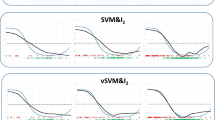Abstract
An adaptive algorithm to solve a wide range of problems of unsupervised learning by constructing a sequence of interrelated extremal principles was proposed. The least squares method with a priori defined weights used as a starting point enabled determination of the “center” of learning sample. Next, a natural passage from the least squares method to more flexible extremal principle enabling adaptive determination of both the “center” and weights of the learning sample events was performed. Finally, a universal extremal principle enabling determination of the scaling coefficient of the membership function in addition to the “center” and weights was constructed.
Similar content being viewed by others
References
Dumitrescu, D., Lazzerini, B., and Jain, L.C., Fuzzy Sets and Their Application to Clustering and Training, Washington: CRC Press, 2000.
Herbrich, R., Learning Kernel Classifiers: Theory and Algorithms, Cambridge: MIT Press, 2002.
Aizerman, M.A., Braverman, E.M., and Rozonoer, L.I., Metod potentsial’nykh funktsii v teorii obucheniya mashin (Method of Potential Functions in the Machine Learning Theory), Moscow: Nauka, 1970.
Schölkopf, B. and Smola, A.J., Learning with Kernels: Support Vector Machines, Regularization, Optimization, and Beyond, Cambridge: MIT Press, 2002.
Haussler, D., Convolutional Kernels on Discrete Structures, Technical Report UCSC-CRL-99-10, Computer Science Department, Santa Cruz: Univ. California, 1999.
Petrovskiy, M.I., A Hybrid Method for Patterns Mining and Outliers Detection in the Web Usage Log, in AWIC’03, 2003, pp. 318–328.
Tikhonov, A.N. and Arsenin, V.Ya., Metody resheniya nekorrektnykh zadach (Methods to Solve Ill-posed Problems), Moscow: Nauka, 1986.
Ben-Hur, A., Horn, D., Siegelmann, H.T., and Vapnik, V., Support Vector Clustering, J. Machine Learning, 2001, vol. 2, pp. 125–137.
Chih-Chung Chang and Chih-Jen Lin., LIBSVM—a Library for Support Vector Machines (http://www.csie.ntu.edu.tw/:_cjlin/libsvm).
Bottomley, L., Dataset: a Day of http Logs from the EPA www Server, Duke Univ., 1995 (http://ita.ee.lbl.gov/html/contib/EPA-http.html).
Petrovskiy, M.I., A Fuzzy Kernel-Based Method for Real-Time Network Intrusion Detection, in IICS, 2003, pp. 189–200.
Petrovskiy, M.I., Outlier Detection Algorithms in Data Mining Systems, Program. Comp. Softw., 2003, vol. 29, no. 4.
Mashechkin, I., Petrovskiy, M., and Rozinkin, A., Enterprise Anti-Spam Solution Based on Machine Learning Approach, in ICEIS (2), 2005, pp. 188–193.
Adaptive Security Analyzer Pro. Privacyware®, 2005 (http://www.privacyware.com/index_ASAPro.html).
InTrust® for Windows. Quest Software®, 2005 (http://www.quest.com/products/pdfs/Product_Guide.pdf).
Author information
Authors and Affiliations
Additional information
Original Russian Text © K.V. Mal’kov, D.V. Tunitskii, 2008, published in Avtomatika i Telemekhanika, 2008, No. 6, pp. 41–52.
This work was supported in part by PWI, Inc.
Rights and permissions
About this article
Cite this article
Mal’kov, K.V., Tunitskii, D.V. On one extremal problem of adaptive machine learning for detection of anomalies. Autom Remote Control 69, 942–952 (2008). https://doi.org/10.1134/S0005117908060052
Received:
Published:
Issue Date:
DOI: https://doi.org/10.1134/S0005117908060052




